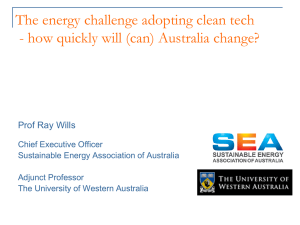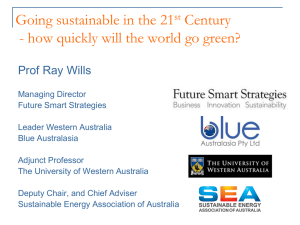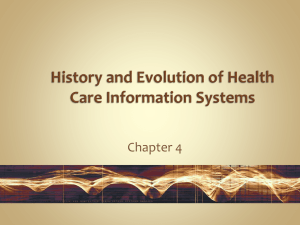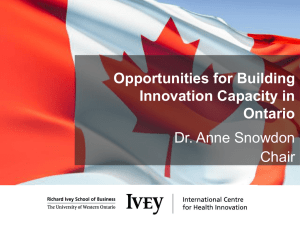Technology Overview
advertisement
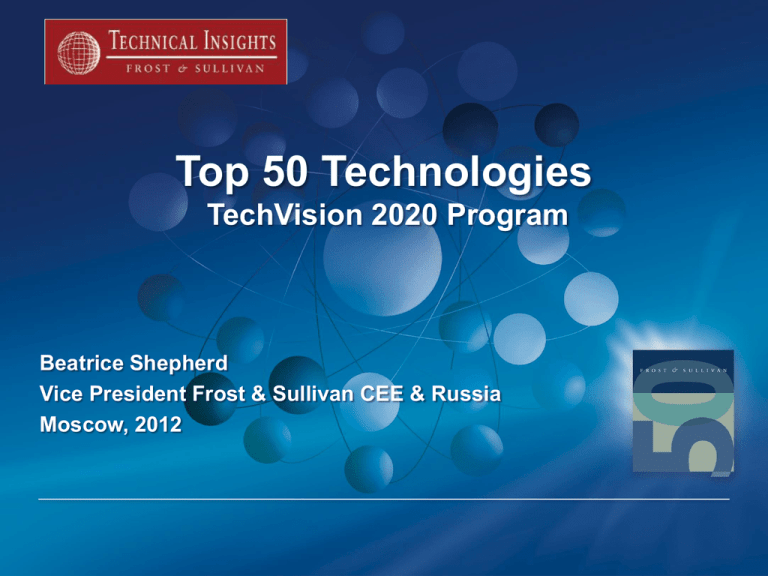
Top 50 Technologies TechVision 2020 Program Beatrice Shepherd Vice President Frost & Sullivan CEE & Russia Moscow, 2012 Global Top 10 Hot Technologies to Invest “Valley of Death” “Diffusion of Innovation” Top 10 Hot Technologies Map of the Complex ‘Innovation’ Universe TECHNOLOGY Emerging Technology Healthcare Emerging Competition Green Technologies Software Technology Due diligence Biotech Technology Marketing CUSTOMER Innovation Center INTELLECTUAL PROPERTY IP Strategy Country Risk Open Innovation Licensing Strategies Innovation Models Disruptive Technologies Industry Shifts Patent Risk: Patentability Assessment INDUSTRY Market Assessment Economic Trends Industry Expansion Potential BEST PRACTICES Economic Development GLOBAL Nano Technology Disclosure Analysis Competitive Strategy Growth Team ECONOMIC Behavior New Applications COMPETITIVE In-Direct Competition Valley of Death (VoD) Investor’s Guide: What, Why and How to avoid? Given the dangers of falling into the “Valley of Death”, investors need to closely assess the potential of a given technology platform to understand the true market potential it holds and to evaluate the risk-reward elements Global Top 10 Hot Technologies to Invest “Valley of Death” “Diffusion of Innovation” Top 10 Hot Technologies Diffusion of Innovation (DOI) Process, Dynamics, Stakeholder, Applications, Impact ‘Dynamics’ of Tech Development ‘Stakeholders’ fuelling the Dynamics Universities/R&D Institutes Companies Need Funding (entire value chain) Combined influence Opportunity Government End-users Entities Capability Regulatory Bodies Venture Capitalists Associations Stages of Tech Development Technology Basic Research 1 Applied R&D 2 Tech platform ready for addressing ‘primary’ application needs Demonstration 3 Time lag Commercialization 4 Original tech platform finds use in newer applications Diffusion of Innovation (DOI) … Example – Wireless Sensor Networks (WSN) Estimated Global Market Size by 2014 = $2.9 Billion Current technology is based on a number of platforms driven by different industry stakeholders: IEEE 802.15.4, ZigBee, 6LoWPAN etc. Diffusion Rate Cross Over Point The cumulative impact of the different rates is on the tech and its continued adoption over a period of time. Healthcare Building Automation Industrial Automation Location & Tracking Environment & Agriculture Mission Critical (Nuclear Plants, Space) Early Adopters 2006 2007 Followers 2008 2009 Laggards 2010 Based on a derivative of ‘Bass Diffusion model’, the DOI curve indicates the different rates at which markets/ applications are expected to adopt “Wireless Sensor Networks” (WSN). 2011 2012 2013 Time The landscape also witnesses ‘cross over points’ whereby driven by multidimensional factors, a certain industry becomes the ‘lead driver’ over ‘early adopter’ – signalling a change in evolutionary pattern. Example: Wireless Sensor Network (WSN) - Industrial Automation & Building Automation find greatest WSN Source: Frost & Sullivan. technology penetration with other applications following it as reliability increases & cost decreases in the future Top 10 Hot & Emerging Technologies … Approach Selection Methodology 1. For the purpose of this exercise, Frost & Sullivan used the Technology Analysis Framework (TAF) 2. Interrelation & dynamics between these focal points govern technology development, adoption and deployment in any industry for any technology Step 0 Framework finalization Step 1 Collection of Technologies across Industries • Create a pool of technologies (> 25) that are poised to have a significant impact in the near-mid term Step 2 2 phased evaluation of Technologies to identify the top candidates • Develop 1st level filter criterions to assess true potential of technologies across applications • Arrive at the final list of top 10 global technologies by testing them against 2nd level criterions Top 50 Technology Web Global Top 10 Hot Technologies to Invest “Valley of Death” “Diffusion of Innovation” Top 10 Hot Technologies Nanomaterials: Technology Snapshot 2 3 1 1 4 5 Technology Adoption Technology Overview Why is it important? Year of Impact 4 2.5 2.5 0 3 2 5 0 Technology Maturity • Nanocatalysts utilize nanomaterials for homogenous and heterogeneous catalytic reactions. They increase the functionality and specificity of the catalytic reactions, while reducing the reaction time. Nanocatalysts can be particulate, porous, crystalline or supra molecular in nature. They are used in applications pertaining to alternative energy, pharmaceuticals, oil and gas to name a few. • Nanocatalysts exhibit better performance than conventional catalysts. Their nanoscale nature results in the greater availability of catalyst, leading to increased catalytic performance and utilization of raw materials, faster reaction time, and improved quality of the reactions. Nanocatalysts are ecologically benign and are consider “green” when compared to conventional catalysts. • You’ll see nanocatalysts making an impact this year; they will have a significant impact in the Alternate Energy and Oil and Gas sectors for fuel conversion reactions and biofuel synthesis. The nanocatalysts has applications in drug delivery, gene therapy and biosensors in the pharmaceutical industry. They can be used in the manufacture of cosmetics, agrochemicals, plastics and industrial chemicals. Nanomaterials: Technology Development and Adoption Footprint North America •DOE and NSF funding has led to the development and adoption of nanocatalysts in the manufacture of biofuels, fine chemicals and water purification methods. •Industrial funding in the pharmaceutical and personal care sector has enabled the use of nanocatalysts for drug delivery, gene therapy, biosensors and cosmetics. Europe •Stringent government regulations and funding from DEFRA has driven the applications of nanocatalysts for developing biofuels and use iin waste water treatment. •Automobile companies are funding the research and development of nanocatalysts for fuel cells and portable power units China / Japan / Taiwan •The countries are concentrating on developing nanocatalysts for chemical industry. Middle East •Industries and universities fund the development of nanocatalysts in crude oil desulfurization, catalytic cracking and reforming of petroleum; this has led to the adoption of nanocatalysts in the oil and gas sector. Intensity of Technology Development Very High High Medium Low Very Low India •Research is still in developmental stages •Industrial collaborations have resulted in the use of nanocatalysts for the manufacture of fine chemicals Australia •Australia is working on the use of nanocatalysts for fuel cells and auto catalysts Source: Frost & Sullivan. Smart Textiles: Technology Snapshot 3 2 1 1 4 5 Technology Adoption 4 2.5 1.75 0 3 2 5 0 Technology Maturity Technology Overview • Smart textiles are defined as textiles capable of superior performance thought the aid of electronics and superior engineered materials. • In the most recent Olympics, we witnessed several new world records in swimming, partly due to technologically enhanced swimsuits. Why is it important? • Smart textiles as a market has seen exponential growth over the past few years. • Apart from being applicable for sports, smart textiles are used in healthcare protective gear and military applications • Currently, the smart textiles market is fragmented as the technology caters to high end and niche applications. Year of Impact •The technology for smart textiles is expected to be widely adopted in some niche applications such as firefighting and sports in the next two to three years provided the issues related to cost and ease of manufacturing in large scale are overcome. Smart textiles have the potential to become fashionable yet life saving. Smart Textiles: Funding Trends Application Sectors Speciality Applications 14% Military Healthcare Military 38 % Sportswear 19% Sports Wear Specialty Applications Healthcare 29% • The largest area of application is military apparel. This is because any advantage in a combat field can never be underestimated. In this regard, smart textiles have the ability to provide superior camouflage functionality. This benefit has driven increased government funding for smart textiles in the recent years. • The next most significant area of research focus is Healthcare. This is driven by high costs of specialist healthcare personnel. • Sportswear is also a key area of research focus as the textiles used in sports applications provide some superior characteristics when compared to normal wear. For example, swimwear can show superior hydrophobic properties. Advanced Batteries and Energy Storage Micro UAV Electric Vehicle Fuel Cell Solider Modernization Human Energy Harvesting Advanced Batteries and Energy Storage: Funding Trends Funding from DOE and Recovery Act for Energy Storage, 2009 - 2010 Public spending on transportation-related energy storage, 2008‐ 2011 $50 million $597 million $271 million Source: IEA, 2011 • The US government began active funding of advanced energy storage R&D only in the last few years. • The high portion of US public spending in energy storage for transportation is mainly due to $400 million being set aside for demonstration purposes, whereas grid-scale demonstration has been provided a budget of $185 million. • In late 2009, DOE awarded grants for the construction of 150MW/10-hour and 300-MW/10-hour advanced secondgeneration CT-CAES units to New York State Electric & Gas and PG&E, respectively. • Discounting China from the top spenders of public spending (due to the unavailability of data), the US, Japan, Germany and France then emerge as the Top 4 spenders with regards to energy storage for transportation applications, due to the countries ’ association with automotive manufacturing. • Interestingly, spending on fuel cell RD&D actually outpaced that of batteries. Advanced Batteries and Energy Storage: Technology Landscape Uninterruptable Power Supply Power Quality Transmission & Distribution Grid Support Load Shifting and Leveling Lithium air (Li-air) & Lithium sulfur (Li-S) Basic R&D Phase Change Materials Bulk Power & Energy Management Superconducting Magnetic Energy Storage (SMES) Fuel Cells Advanced Lead-Acid Flow Batteries (Vanadium Flow, Vanadium Redox, Zinc-Bromine, etc.) Lithium Ion (Li-ion) DemonstrationScale Flywheels Ultra-/Supercapacitors Sodium Nickel Chloride (Na/NiCl2) Compressed Air Energy Storage (CAES) Nickel Cadmium (NiCd) Commercial Sodium Sulfur (NaS) Molten Salts Lead-Acid Batteries Mature Nickel Metal Hydride (NiMH) 1 kW 100 kW 1 MW 100 MW System Power Ratings, Module Size Pumped Hydro 1 GW Thin film PV United States The US Department of Energy (DOE) supported the Solar Energy Technologies Program (SETP) with $225 million in 2010 and $117 million from the Recovery Act. In 2010, the DOE funded the third and final year of more than 20 Next Generation program projects in 11 different areas. A total of $8 million will be set aside for the development of advanced thin films. Intensity of Technology Development Very High High Medium Key Insight: Solar accounted for 27% (119 deals in 2010) of the overall number of VC and Private Equity investments in the Renewable Energy Sector Germany In 2010, the Federal Environment Ministry (BMU) provided EUR 39.1 million to support R&D projects on PV, spread out over 152 projects. In the area of thin film, focus was on silicon and CIS technologies. In addition, Germany has several active companies in thin film PV, including silicon thin film (10 companies, 420 MW production capacity), CIS (11 companies, 310 MW) and CdTe (3 companies, 260 MW) China Installation of PV in China is largely due to the desire to improve rural infrastructure. Although China has emerged to become the largest producer of PV modules in the world, the country is still relatively weak in thin film R&D. Most thin film R&D is undertaken by the academic sector, where certain R&D institutions have developed thin film PV with higher efficiencies, including Nankai University (CIGS, 14.3%), and Sichuan University (CdTe, 13.4%). France A major R&D project in France is POLYSIL, which started in December 2009. Focusing on the development of thin film PV, the project aims to give France a leading edge in thin film PV technology. Another key stakeholder is IRDEP, a R&D institution that is focusing on reducing production costs of PV modules, improved PV conversion efficiencies and processes for thin film deposition. Low Very Low Source: Frost & Sullivan. Thin Film PV: Funding Trends Public spending on Solar PV RD&D for selected countries, 2010 • Many countries are still investing a large percentage of their public R&D spending on R&D and deployment of solar technologies. • Top national spenders were USA, Japan, Korea, France and Australia. • Data on public spending in China was not available. However, based on China’s interest on clean energy R&D, it is expected that public spending would be higher, or at least equivalent to that of USA. Venture capital spending on Thin Film PV, 2007 - 2008 • Between 2007 and 2008, more than $1.6 billion in venture capital was invested globally in thin film PV, which has resulted in the establishment of more than 100 start-ups. • Most VC investment was focused on CIGS, which has shown the highest efficiencies among all the thin film PV technologies, although manufacturing costs for CIGS are still relatively higher. • Of the 10 largest clean-tech VC deals in USA in 2010, three were for thin film PV (Solyndra, Abound Solar and Miasole), with an average investment of $130 million. Renewable Chemicals: Technology Snapshot 3 2 1 2 1 4 2.0 Technology Adoption 4 2.0 5 0 3 0 5 Technology Maturity Technology Overview • Renewable chemicals refers to the development of environmentally friendly, sustainable chemicals that can be used to replace traditional petrochemicals. • The main feedstock for renewable chemicals are usually obtained from sugar, starch and vegetable oil feedstock. Biomass can also be used as a feedstock, but requires pretreatment processing to convert it to simple sugars. • The simplest method to produce renewable chemicals is by using fermentation. Why is it important? • Renewable chemicals are considered a more environment-friendly alternative to chemicals derived from fossil fuels. Increased adoption of renewable chemicals will lead to less carbon emissions, as well as reduced environmental impact. • The production of renewable chemicals is also driven by the volatility of oil prices, as bulk chemical producers are attempting to widen their product portfolio so as to lessen their risk towards volatile oil prices. Year of Impact • Renewable chemicals have been available for several years, with the first sector to be impacted being the plastics industry, with the introduction of bioplastics made from polylactic acid (PLA) and polyhydroxyalkanoates (PHA). • Other renewable chemicals expected to be commercialized soon are succinic acid, butanol, acrylic acid, butanediols, propanediols, lactic acid, glycerine, adipic acid, ethanol, glucaric acid, propylene glycol, acetyls, and furanics. Advanced Manufacturing: Technology Snapshot 2 3 1 2 1 4 2.5 0 Technology Overview 0 5 Technology Maturity • Digital Manufacturing technology refers to the use of simulation tools and product lifecycle management software, and ICT solutions to achieve higher productivity in manufacturing, thereby increasing competitiveness. • The removal of global trade barriers, and the creation of globally distributed manufacturing necessitates the transition to a digital manufacturing enterprise. • Also, called e-manufacturing technologies in this domain facilitate the link between the ‘top floor’ and ‘shop floor’ wherein information from plant automation and control systems can be fed to higher level information layers of the enterprise for decision making and strategy management. • Why is it important? 4 3.0 5 Technology Adoption 3 There is a dire need to achieve a competitive edge with low cost overseas manufacturing locations, and this applies to small and medium scale enterprises (SMEs) as well. This can be achieved by utilizing digital manufacturing to achieve cost economics, reducing time to market of products, improving responsiveness to customers, and acquiring the ability for mass customization. • Companies can keep pace with competition for developing futuristic products if product lifecycle management (PLM) solutions are adopted, and simulation tools are effectively used for product development and process optimization. Impact • Usage of digital manufacturing for collaborative new product design, agile manufacturing, and supply chain integration can be seen in competitive markets. However, there is tremendous untapped potential across several manufacturing streams, which include small and medium scale enterprises. Advanced Manufacturing: Technology Development and Adoption Footprint Europe North America • Companies utilizing digital innovation for new product launches using product lifecycle management tools and software • Direct digital manufacturing of intricate parts for medical devices, and electronics • Adoption of new materials in manufacturing accelerated by modelling and simulation tools, especially by aerospace and automotive sectors Innovative concepts such as mass customization facilitated by digital manufacturing • Oil & Gas and chemical industry adoption of process simulation on the rise. Industry using smart manufacturing solutions provided by companies such as Aspen technology, ANSYS Intensity of Technology Development Very High High Medium Low Very Low • Companies such as ABB are establishing fully industrial IT-driven manufacturing facilities • Companies like SAP, Siemens offer product management (PLM) software platforms lifecycle • Several ongoing EU framework programme projects working towards the realization of fully IT-enabled industrial automation and enterprises India • Indian software majors such as Wipro, Infosys and Mahindra Satyam are developing software technologies that will enable a connected, networked engineering environment and enterprise. • Wipro offers solutions that can help analyze, report and track key indicators of sustainability in a manufacturing organization • Challenges exist for the use of fully integrated enterprises until industrial communication systems and networks are upgraded across factories China / Japan / Korea • Auto manufacturers, and manufacturers in electronics, semiconductors and electronics are adopters of digital manufacturing. • Vast untapped potential still exists in these markets • Companies rapidly adopting PLM, virtual manufacturing, and virtual engineering such as usage of 3D CAD tools for modelling and simulation for new product development. • Digital manufacturing solutions are being leveraged for the expansion of manufacturing units Source: Frost & Sullivan. 3D Integration System-InPackage (SiP) 3D Integration Approaches System-OnChip (SoC) Illustrations 3D Integrated Circuit (IC) Critical markers for sector growth The Road Ahead Flexible Electronics Technology Potential Markets with connected needs Medical Devices Consumer Electronics Military Supply Chain Food Packaging Current Developments/Products Market Potential Global CAGR (2009 - 2014) >19% North America – 28% Europe – 32% APAC – 36% ROW – 4% Flexible Electronics: Patent Landscape Top Patent holders in the area of Flexible Electronics: Konarka holds more patents in this area. Geography wise Patent Distribution: Innovations emerging from North America is observed to be more compared to other regions of the world. Patent Distribution as per Inventor Geographical Location: While United States has the highest number of inventors, certain regions of Europe and Israel also has strong foothold in this industry. Patent Filing Trend as per Publication Years: While the US applications follow a nearly constant trend in the past 5 years, European patents have risen marginally. Semantic Web: Technology Snapshot 3 2 1 1 4 5 Technology Adoption 4 3.5 3 0 3 2 5 0 Technology Maturity Technology Overview • Semantic Web Technology is a collation of different methods and technologies that serve as an extension to the web by appending new data and meta data to the existing content. This technology empowers the computer to process and understand the data available on the web, extrapolate useful information for the user • It incorporates markup languages, frameworks, querying tools such as Web Ontology Language (OWL) and Resource Description Framework (RDF) Why is it important? • Semantic Web adds meaning and structure to the content on the web. It assists the computer to understand relationships between different data sources to make logical connections and decisions • Equips the software agent to identify, analyze, evaluate and combine the information across multiple resources. Performs sophisticated tasks for end users, automates different operations with minimal human intervention Year of Impact • Semantic web has become the buzz word of the internet since 2010. The semantic web space has witnessed the rise of start ups and consumer based product offerings. With enterprise inclination towards intuitive analytics continuing to increase, 2012 and 2013 could be rightly cited as the years of major impact for semantic technologies • Generation of critical insights from customer experience data offers significant business potential across verticals Long Term Evolution:Technology Snapshot 2 3 1 1 4 5 Technology Adoption 4 3.5 2.7 0 3 2 5 0 Technology Maturity • Long Term Evolution (LTE) is a fourth generation (4G) cellular network technology that promises to offer enhanced data rates and capacity for mobile broadband connectivity Technology Overview Why is it important? • The technology has garnered the attention of several large carrier network operatorsmany operators have abandoned WiMAX, a competing 4G technology, in favour of LTE. • Cellular network operators across the globe have been struggling to support the surging data traffic on their networks. With the advent and widespread adoption of powerful smartphones, mobile data traffic has risen drastically • LTE, owing to its ability to facilitate improved data rates and capacity, is cited as a solution for cellular network capacity crunch Year of Impact • The time division duplex (TDD) version of LTE is expected to be widely deployed as the availability of unpaired spectrum can be leveraged for LTE TDD deployments. Major deployments are expected in India in 2011, followed by China and Japan in 2012 Genome Sequencing: Technology Snapshot 3 2 1 1 4 5 Technology Adoption 4 3.5 4 0 3 2 5 0 Technology Maturity Technology Overview • Following the complete sequencing of the human genome and the availability of the annotated human genome sequence online, DNA analysis has become a routine procedure. • Emergence of novel technologies for global genomic analysis (high throughput sequencing, transcript profiling, SNP genotyping), haplotype mapping, and bioinformatics has revolutionized the information available about the human genome. Why is it important? • Genomics provides structural and organizational information and aims to improve the ability to predict the manner in which genetic variation affects susceptibility to disease, response to medical treatments, and how other important phenotypes, will have a transformative effect on health care. • Reductions in sequencing costs and improvements in the speed at which sequences can be generated are ushering the era for personal genomics. Year of Impact • Automated procedures are commercialized to prepare DNA for sequencing and analysis broadly for health assessment, therapeutic decisions, and predicting phenotypes of interest. • Entire human genome can now be sequenced for a retail cost of $20,000 and NHGRI part of the U.S. National Institute of Health has set a target to be able to sequence a humansized genome for US $1,000 by 2014 Thank You Beatrice Shepherd Vice President Frost & Sullivan Frost & Sullivan CEE, Russia and CIS beatrice.shepherd@frost.com Frost & Sullivan celebrate its 50th year in business in 2011! Emerging Research Growth Partnership Visionary Innovation 1961–1990 1990–Today Today–Future 1961 1990 Today

